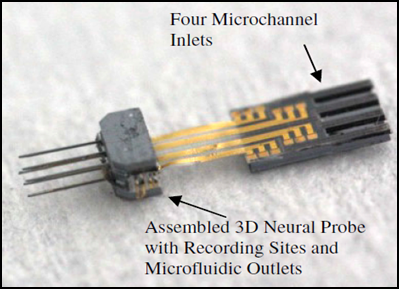WSU researchers have developed a unique design for neural probes with both electrical and chemical interfaces, via arrays metal electrodes and micro-channels that can be easily manufactured and folded in 3D arrays. The fabrication process is post-CMOS compatible allowing simple, reliable and cost effective construction of the all the components. Methods to produce flexible electronics have developed not only foldable 3D arrays but also flexible cables, tubes and novel hybrid tips that should help reduce the mechanical mis-match between brain tissue and conventional wire or silicon based electrodes. The micro-channels allow for localized drug delivery combined with monitoring of the brain response. Example chemicals include neurotransmitters for chemical stimulation or regulation of neurons, drugs to reduce tissue inflammation, prevent biofouling, promote neuron growth, and treat certain disease
Competitive Advantages
• High density 3D probe arrays
• Integrated microchannels & electrodes
• Foldable & Flexible construction compatible w/ CMOS fabrication
• Optimized for long-term insertion

Benefit Analysis
Neural probes are critical devices for neuroscience research, neural prosthesis applications, and treatment of various neural disorders. Neuro stimulation and recording of electrical signals in the brain using multi-electrode arrays is growing as a method to treat a range of neurological and neuropsychiatric disorders. MEMs design of neural probes including the well-known “Michigan Probes” from NeuroNexus and Utah electrodes allow for higher spatial resolution and precision in locating neural clusters inside the brain. Nevertheless, the long term stability of many of these devices has raised repeated concerns with complications upon insertion and mechanical mismatches between rigid silicon and soft neural tissue.
Stage of Development: Pre-clinical
• Preliminary animal models showing recording of electronic signals for duration of experiment
• Investigations in tinnitus & epilepsy signals
Patent Status
Pending US patent 12/737,126 + Pending provisional patents
References:
“A robust polymer microcable structure for flexible devices" Appl. Phys. Lett. 102 2013
“Microfabrication of 3D neural probes with combined electrical and chemical interfaces” J. Micromech. & Microeng. 21(10) 2011